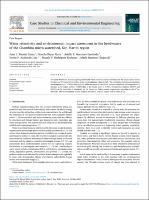Water retentivity and environmental impact assessment in the headwaters of the Chambira micro-watershed, San Martin region

View/
Author(s)
Pinedo Canta, Juan J.
Rojas Alava, Fiorella
Guerrero Escobedo, Adolfo E.
Azabache Liza, Yrwin F.
Rodriguez Espinoza, Ronald F.
Ramirez Chujutalli, María
Date
2023-05-12Metadata
Show full item recordPublisher
Elsevier
Journal
Case Studies in Chemical and Environmental Engineering
Abstract
The study found that maximum precipitation and water retention occur in February for the Cacao sector and in October and February for the Caliza sector, with minimum values in July. The correlation between precipitation and temperature is −0.43 for both sectors, while the negative correlation between retentivity and temperature is stronger in the Caliza sector (−0.467) than in the Cacao sector (−0.096). Precipitation explains 82.07% and 89.92% of the variability in retentivity for the Cacao and Caliza sectors, respectively, according to the R2 coefficients. The environmental impact analysis indicates a medium impact with a value of 5.6.
Type
info:eu-repo/semantics/article
Rights
info:eu-repo/semantics/openAccess
Language
eng
Collections
- Ingeniería Ambiental [98]

